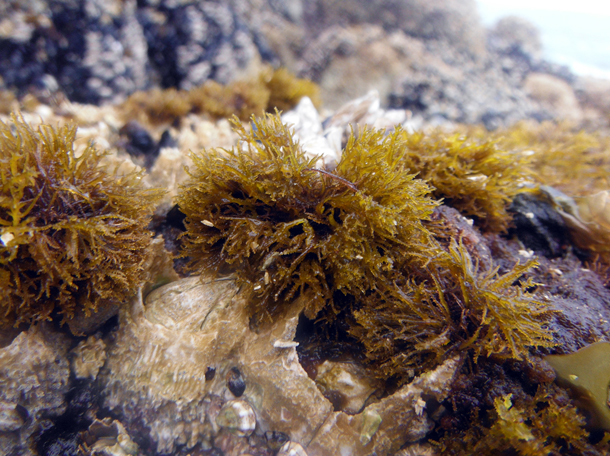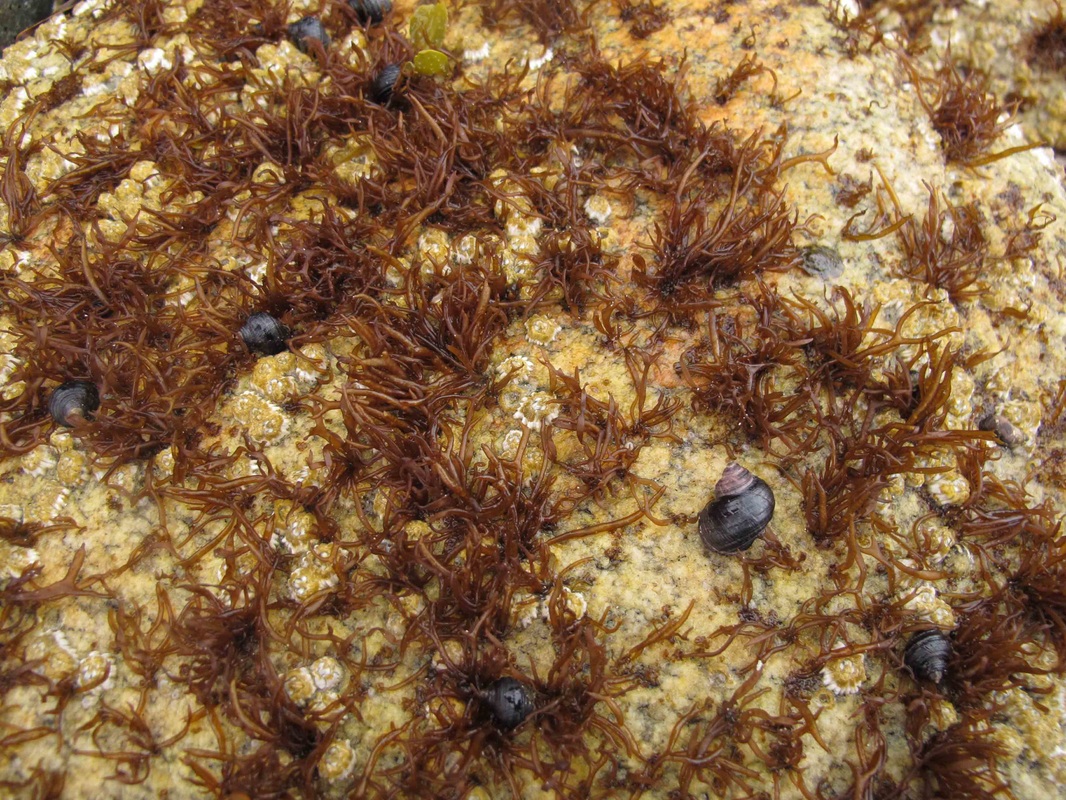Jelly moss, red-brown mat weed • Gloiopeltis furcata
Identification
This red alga can vary between red, brown and yellow in colour and gets up to 5 cm tall. The thallus grows from a reddish perennial basal crust that sports new growth each spring. This growth has a tufted appearance and is composed of rubbery branches that fork fork infrequently and are cylindrical in cross-section. When wet the branches are slippery. The thallus darkens in colour as it dries out, and can be almost black.
Habitat & Range
Jelly moss is most often found in the high to mid-intertidal of semi-exposed to protected Pacific coastlines. Its range extends from the Bering Sea south to China in the west Pacific and Mexico in the east.
Similar Species
Sea moss (Endocladia muricata) may appear similar, but can be differentiated upon close examination as short "spines" dot its branches. By contrast the branches of jelly moss are smooth, and slippery when wet. It is also usually less bushy than sea moss. The two may be found growing together, though sea moss is hardier and tends to be found in more exposed locations.
Intriguing Info
Dry specimens of jelly moss are very brittle and smash easily when stepped on, yet will rehydrate easily once the tide rises back to their level.
iNaturalist
https://www.inaturalist.org/taxa/362429-Gloiopeltis-furcata
This red alga can vary between red, brown and yellow in colour and gets up to 5 cm tall. The thallus grows from a reddish perennial basal crust that sports new growth each spring. This growth has a tufted appearance and is composed of rubbery branches that fork fork infrequently and are cylindrical in cross-section. When wet the branches are slippery. The thallus darkens in colour as it dries out, and can be almost black.
Habitat & Range
Jelly moss is most often found in the high to mid-intertidal of semi-exposed to protected Pacific coastlines. Its range extends from the Bering Sea south to China in the west Pacific and Mexico in the east.
Similar Species
Sea moss (Endocladia muricata) may appear similar, but can be differentiated upon close examination as short "spines" dot its branches. By contrast the branches of jelly moss are smooth, and slippery when wet. It is also usually less bushy than sea moss. The two may be found growing together, though sea moss is hardier and tends to be found in more exposed locations.
Intriguing Info
Dry specimens of jelly moss are very brittle and smash easily when stepped on, yet will rehydrate easily once the tide rises back to their level.
iNaturalist
https://www.inaturalist.org/taxa/362429-Gloiopeltis-furcata
References
Lamb, A., and Hanby, B. (2005). Marine Life of the Pacific Northwest [electronic version]. Madeira Park, BC: Harbour Publishing.
Lindberg, M. and Lindstrom, S. (2010). Gloiopeltis furcata. Seaweeds of Alaska. Accessed 01/12/2014.
O'Clair, R. and Lindstrom, S. Gloiopeltis furcata (Postels et Ruprecht) J. Agardh. In Klinkenberg, Brian. (Ed.). E-Flora BC: Electronic Atlas of the Plants of British Columbia. Lab for Advanced Spatial Analysis, Department of Geography, University of British Columbia, Vancouver. Accessed 01/12/2014.
Authors and editors of page
Kelly Fretwell, Bridget Woods, and Brian Starzomski (2014).
Lamb, A., and Hanby, B. (2005). Marine Life of the Pacific Northwest [electronic version]. Madeira Park, BC: Harbour Publishing.
Lindberg, M. and Lindstrom, S. (2010). Gloiopeltis furcata. Seaweeds of Alaska. Accessed 01/12/2014.
O'Clair, R. and Lindstrom, S. Gloiopeltis furcata (Postels et Ruprecht) J. Agardh. In Klinkenberg, Brian. (Ed.). E-Flora BC: Electronic Atlas of the Plants of British Columbia. Lab for Advanced Spatial Analysis, Department of Geography, University of British Columbia, Vancouver. Accessed 01/12/2014.
Authors and editors of page
Kelly Fretwell, Bridget Woods, and Brian Starzomski (2014).






